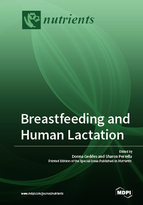Breastfeeding and Human Lactation
A special issue of Nutrients (ISSN 2072-6643).
Deadline for manuscript submissions: closed (31 July 2018) | Viewed by 255182
Special Issue Editors
Interests: human milk composition; breastfeeding; milk production; milk removal; infant feeding; infant body composition
Interests: human milk composition; breastfeeding; milk production; milk removal; infant feeding; preterm infant feeding; gastric emptying
Special Issue Information
Dear Colleagues,
Human lactation has evolved to produce a milk composition that is uniquely-designed for the human infant. Not only does human milk optimize infant growth and development, it also provides protection from infection and disease. More recently, the importance of human milk and breastfeeding in the programming of infant health has risen to the fore. Anchoring of infant feeding in the developmental origins of health and disease has led to a resurgence of research focused in this area.
Milk composition is highly variable both between and within mothers. Indeed the distinct maternal human milk signature, including its own microbiome, is influenced by environmental factors, such as diet, health, body composition and geographic residence. An understanding of these changes will lead to unravelling the adaptation of milk to the environment and its impact on the infant. In terms of the promotion of breastfeeding, health economics and epidemiology is instrumental in shaping public health policy and identifying barriers to breastfeeding. Further, basic research is imperative in order to design evidence-based interventions to improve both breastfeeding duration and women’s breastfeeding experience. On this topic, you are invited to submit proposals for manuscripts that study the many varied aspects of human lactation.
Assoc. Prof. Dr. Donna GeddesDr. Sharon Perrella
Guest Editors
Manuscript Submission Information
Manuscripts should be submitted online at www.mdpi.com by registering and logging in to this website. Once you are registered, click here to go to the submission form. Manuscripts can be submitted until the deadline. All submissions that pass pre-check are peer-reviewed. Accepted papers will be published continuously in the journal (as soon as accepted) and will be listed together on the special issue website. Research articles, review articles as well as short communications are invited. For planned papers, a title and short abstract (about 100 words) can be sent to the Editorial Office for announcement on this website.
Submitted manuscripts should not have been published previously, nor be under consideration for publication elsewhere (except conference proceedings papers). All manuscripts are thoroughly refereed through a single-blind peer-review process. A guide for authors and other relevant information for submission of manuscripts is available on the Instructions for Authors page. Nutrients is an international peer-reviewed open access semimonthly journal published by MDPI.
Please visit the Instructions for Authors page before submitting a manuscript. The Article Processing Charge (APC) for publication in this open access journal is 2900 CHF (Swiss Francs). Submitted papers should be well formatted and use good English. Authors may use MDPI's English editing service prior to publication or during author revisions.
Keywords
- human lactation
- breastfeeding
- milk composition
- infant feeding
- breast milk
- human milk







